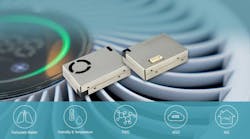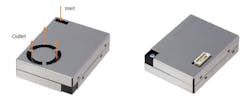Tiny Air Quality Sensor Module Captures, Assesses 7 Indoor Pollutants and Parameters
What you’ll learn:
- Why and how indoor air quality is an increasingly important metric.
- Details of the seven parameters assessed by this all-in-one module.
- The need for a fan to ensure consistent airflow.
Quantitative assessment of indoor air quality (IAQ) is an increasingly desirable and demanded function that’s now mandated in many jurisdictions by environmental and building-code regulations. The challenge is that the simple phrase “air quality” actually encompasses measurement of many pollutant types, and this must usually be accomplished in accordance with strict standards.
Developing an arrangement that provides all of the needed sensors can be a tricky and complicated design effort with interface, packaging, and qualification issues in addition to selection and integration of the sensors themselves.
That’s the challenge addressed by the Renesas RRH62000 All-in-one Air Quality Module. The module, which includes one of the company’s microcontrollers (MCUs), offers an intelligent sensor-management solution for the growing market of air-monitoring applications that includes air purifiers, smoke detectors, HVAC systems, weather stations, and smart-home systems. Its firmware also enables end-user products to comply with various air-quality standards around the world.
The RRH62000 has an extremely small footprint for its class of sensor modules, measuring only 46.6 × 34.8 × 12 mm. It incorporates seven sensors: the laser-based PM1/2.5/10 sensor (PM is particulate matter), a ZMOD4410 gas sensor, and the HS4003 humidity and temperature sensor (Fig. 1). The module delivers the seven sensor outputs simultaneously, and its on-board MCU enables the system to detect surrounding air quality data in real-time.
Air Quality Module Leverages Lasers for Better Precision
Using laser technology, which offers higher precision compared to conventional LED methods, it can monitor and “bin” concentrations of PM1, PM2.5, PM10 particulates—particles with diameters of 0.3 to 10 µm. It can also perform absolute or relative total volatile organic compound (TVOC) measurements in different power-mode settings, providing the highest level of accuracy for these pollutants.
Together, these sensors are able to detect particulate matter, TVOC, estimated CO2, temperature, and humidity in one system. All key components have been pre-integrated and fully calibrated at the factory, making it possible for developers to start their sensor system designs right out of the box.
The sensors are placed within the module housing, which protects against malfunctions from dust accumulation. The airflow channel has a high-speed fan with a self-cleaning mechanism (can’t forget about that), while a six-pin connector provides an easy plug-and-play interface (Fig. 2).
Other Key Features of the RRH62000 Air Quality Module
The RRH62000 provides digital outputs for each sensor. Its output-correction algorithms use the correlation between sensors to improve the accuracy of each measurement and identify detectable substances. In addition, control and arithmetic processing is done within the module, freeing resources on the host MCU and simplifying the implementation on the designer’s side.
The RRH62000 is configurable with the selectable I2C or UART interface and the operating mode depending on response time and accuracy needed. Operating temperature range is from −10 to 60°C while operating humidity range is up to 90% RH. It operates from a single 5-V supply, requiring 40- (typical) and 60-mA (maximum) current when making measurements and 30/50 µA (typical/maximum) in sleep mode.
The RRH62000 combo module comes with building-standard firmware plus artificial-intelligence (AI) algorithms. This lets engineers configure the sensors to conform to the requirements of various green air quality standards in public buildings such as The Well Building Standard (WELL), Home Ventilating Institute (HVI), and the RESET set of standards and assessment tools and services. The module is also qualified to standards set by UBA (Umweltbundesamt, German Federal Environmental Agency) and JEITA ED-4701 (Japan Environmental and endurance test methods for semiconductor devices).
Evaluation Kit for the Sensor Module
For system designers, the associated RRH62000-EVK evaluation kit simplifies the design-in process (Fig. 3). It includes a USB cable, the ESCom board, an RRH62000 integrated sensor module, and a Quick Start Guide, plus downloadable GUI-based software. To initiate use of the sensor, the user simply connects the EVK to a Windows PC via USB and applies the provided evaluation software.
Links to all relevant documents (datasheet, user manual, evaluation kit) are at the module product page. Note that the comprehensive 24-page datasheet goes far beyond the basic design and use issues. It offers a detailed look at relevant chemical and particulate issues and standards and includes many revealing tables and graphs for the module. A blog about the air quality sensor module, which is available now, is also offered at the Renesas website.



